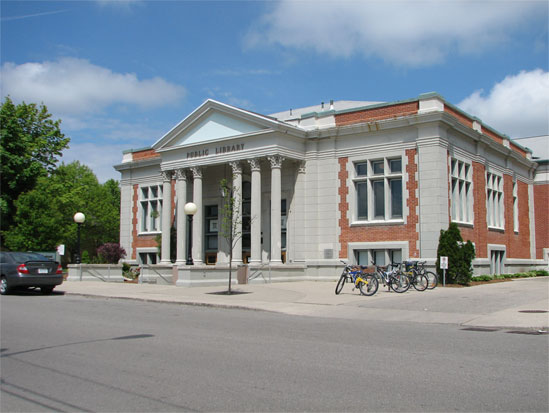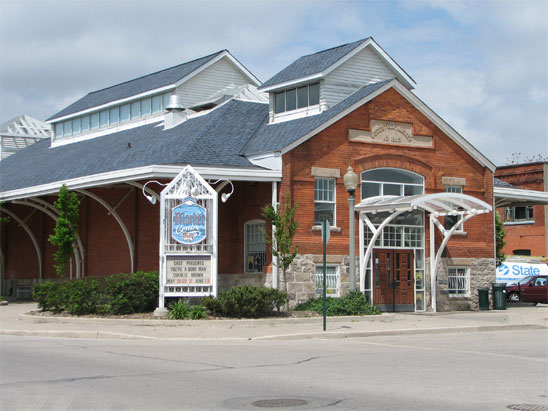Woodstock

If you haven’t been to Woodstock recently, you’re in for a bit of a surprise. This self-proclaimed Dairy Capital of Canada, located along Hwy 401 between Kitchener-Waterloo and London, still holds to its roots in agriculture and manufacturing, but like any forward-thinking municipality, it also knows the importance of modernizing for future economic growth.
Take a trip through downtown Woodstock and you’ll see gorgeous tree-lined streets, century-old Victorian homes, abundant parkland, friendly citizens and even an immortalized Holstein.
But more on that later.
The town’s history is not only preserved in its museum and county courthouse, it is the only municipality in Ontario to still have all of its original public buildings. Combine that with modern amenities such as schools, medical facilities, recreational centres and plenty of greenspace, and you’ll understand why Woodstock is also a town with a bright future.
With a population of about 36,000, Woodstock is the largest municipality in Oxford County in Southwestern Ontario, about 122 kilometres southwest of Toronto, just north off Hwy. 401 along the historic Thames River.
The community was first settled in 1800 after Sir John Graves Simcoe, governor of what was then known as Upper Canada, determined the area would make a good townsite. Early settlers were American immigrants from New York state and then from Britain in the 1820s. In 1902, Woodstock petitioned the provincial legislature to be incorporated as the City of Woodstock.
Downtown Woodstock houses the city’s banks, administration buildings, retailers and several restaurants with the majority of buildings a century old. With free two-hour downtown parking, locals appreciate it’s a great place to shop, work, play and dine. In the 1990s, the city undertook an extensive makeover of the main street, adding gardens and cobbled sidewalks, which now host numerous retail promotions and entertainment in the summer.
Culture
Woodstock doesn’t come alive only in summer, however. Several popular attractions are held throughout the year, including the Canadian Farm Show in September and the Woodstock Wood Show in October both a nod to the city’s roots in agriculture. Then there’s the Woodstock Fair held at the end of August at the fairgrounds, which comprises a midway, contests, concerts and other events. For entertainment of a different variety, Woodstock is also home to OLG Slots, a harness race track and the seven-screen movie theatre, Gallerie Cinemas.
For parklands, Southside Park offers everything from a playground to baseball diamonds and soccer fields, along with a network of walking trails. At the North End of the city is Roth Park, stretching along the Gordon Pittock Reservoir, which also boasts a playground and several kilometres of walking, running and biking trails.
Woodstock has two ice rinks, two at the Community Complex at the south end of the city, and one at the fairgrounds in the central region. Woodstock Soccer Club has an indoor and outdoor soccer park at the north end. For the aquatically inclined, there are two indoor swimming pools Southside Aquatic Centre and the YMCA and the outdoor Lions Pool.

Education
Schools are an important part of any community, and Woodstock has five high schools, including one catholic and one French: Woodstock Collegiate Institute, Huron park Secondary School, College Avenue Secondary School, St. Mary’s Secondary School (catholic) and Ecole Secondaire Ste-Marie (French catholic). Fanshawe College also operates a campus at the south end of the city, and plans to expand to almost double its current size.
Economy
Given Woodstock’s proximity to the U.S. border in Detroit, it shouldn’t come as any surprise that its economy relies on the automotive industry.
In June 2005, Toyota announced plans to build a new $1.1-billion plant on a 1,000-acre undeveloped site in the northeast end of the city the first new auto assembly plant to be built in Canada in two decades. Initially, it was to employ 2,000 people and begin full production of the Toyota RAV4 SUV in November 2008, with a capacity of 150,000 vehicles per year. Today, Toyota’s plants in Woodstock and down the 401 east at Cambridge employ about 6,500 people.
Other auto companies are also important to the local economy. Hino Motors Canada Ltd., a Toyota Motor Co. subsidiary, operates a truck plant at the former General Seating plant in the Pattullo Ridge Business Park near Hwys. 401 and 59. General Motors operates its National Parts Distribution Warehouse, the largest of its kind in Canada, and there are a number of other parts suppliers active in the area.
Diversification
Realizing that a diversified economy is important to stability, growth and protection from the vacillations of any one industry, manufacturers recently announced participation in the local Interactive Manufacturing Innovation Network (iMiN), part of the Excellence in Manufacturing Consortium (EMC). The Oxford Region iMiN that will involve Woodstock is designed to be a fully meshed network of manufacturers, industry sectors, community partners, academic institutions and other stakeholders, which will grow to become a province-wide series of manufacturing networks that facilitates and promotes awareness, excellence and innovation.
Transportation
As with any growing community, Woodstock is also paying attention to improving transportation in the area through a Transportation Master Plan (TMP), under the Municipal Class Environmental Assessment process. The objective of the TMP is to develop a comprehensive plan that will:
» Review existing transportation and traffic operations and downtown
» Review future transportation system improvements to accommodate urban
growth in the city, and
» Develop an implementation strategy to satisfy short-term and longer-term
transportation needs.
Interesting Facts
Woodstock is home of the Springbank Snow Countess a Holstein cow that set a world record lifetime butterfat production of 9,062 pounds. The Countess is forever commemorated by a life-sized statue located downtown at the corner of Dundas and Springbank.
In 2008, the City of Woodstock enacted a comprehensive outdoor smoking bylaw that restricted or banned smoking in parks, recreational fields, transit environments, downtown patios and doorways. A study conducted by the University of Waterloo showed the policy was effective at reducing smoking in regulated environments, helping some smokers to cut back and supporting smoking cessation.
Woodstock at a glance
Population
Approximately 36,000
Major employers
Automotive, parts suppliers,
heavy equipment
Distance from Toronto
122 kilometres
Source Canadian Real Estate Association;
City of Woodstock.
Photos: City of Woodstock

